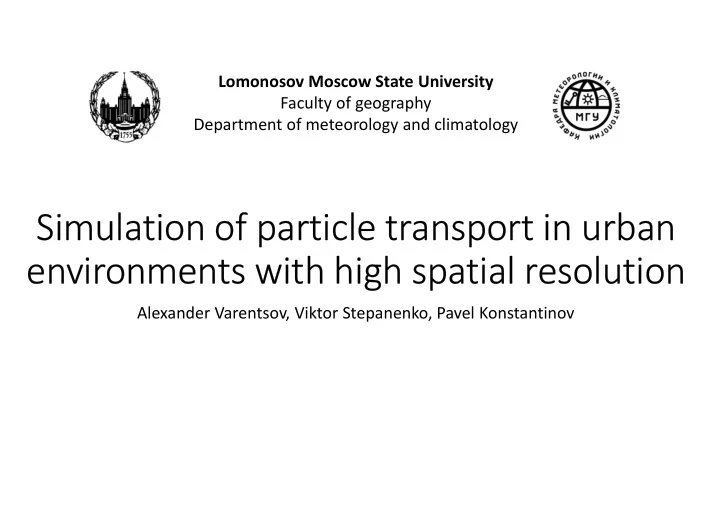

Lomonosov Moscow State University Faculty of geography Department of meteorology and climatology Simulation of particle transport in urban environments with high spatial resolution Alexander Varentsov, Viktor Stepanenko, Pavel Konstantinov
Motivation: atmospheric aerosol Particle size Impact area 5 – 30 μm Nose, Throat, Mouth 1 – 5 μm Trachea, upper bronchi < 1 μm Lungs, circulatory system [Marley, 2006] [https://www.lung.org] [Kasimov, 2016]
Objective Objective: development of lagrangian tool for calculating aerosol dispersion in urban geometry with high spatial resolution Tasks : • Development of physical model of particle advection • Implementation of the scheme in the program code • Testing the model for idealized cases and real urban built-up areas
Particle Advection Physics Newton’s second law Turbulent eddies Motion equation �� �� � � �� � � �� � �� � ��� � � �� F � � � � � � � a � � V m The equation is solved by 4-order [http://www.mcef.ep.usp.br] explicit Runge-Kutta method Medium resistance Interaction with force surfaces Trajectory calculation is possible � � � 3�� � �� for a variety of particles. � 4� � � � � � – particle density � � – drag coefficient � – medium (air) density �� – Reynolds number � � – particle diameter � – flow velocity � � – particle velocity
Testing for idealized flow Circular flow � � ( ) * � Turbulence Parameterization � � � � Flow velocity � � � Laminar flow Turbulent flow � � – pulsation component (normally distributed random variable) start Discrete random walk model � � is generated for every large turbulent eddy � min �� % , � ' � � % – eddy lifetime � ' – eddy crossing time ( � �0,0,1� * – position vector
Urban canyon case Flow vertical velocity 5 m/s Developed model (lagrangian) ENVI_MET model (eulerian) Concentration 5 m/s 5 m/s Concentration, mcg/m3
Close to real conditions Nadym city case Nadym, 400х400 m Flow velocity on 10m – 5 m/s 1.2m level wind velocity PM2.5 concentration on surface Wind velocity on 1.2m level, m/s Concentration on surface, mcg/m3
Conclusions • The 3D microscale Lagrangian model of particle advection was developed and implemented in the program code • The model has ability to calculate the particle dispersion in advanced geometry of urban areas and to accept various types of input data. In perspective this tool could be more accurate, than eulerian method • Simple analytical and close to real conditions tests were successfully carried out
Thank you for attention!
Flat surface: concentration Developed model (lagrangian) ENVI_MET model (eulerian) Flow velocity on 10m – 0.5 m/s Concentration Concentration Flow velocity on 10m – 5 m/s
Recommend
More recommend